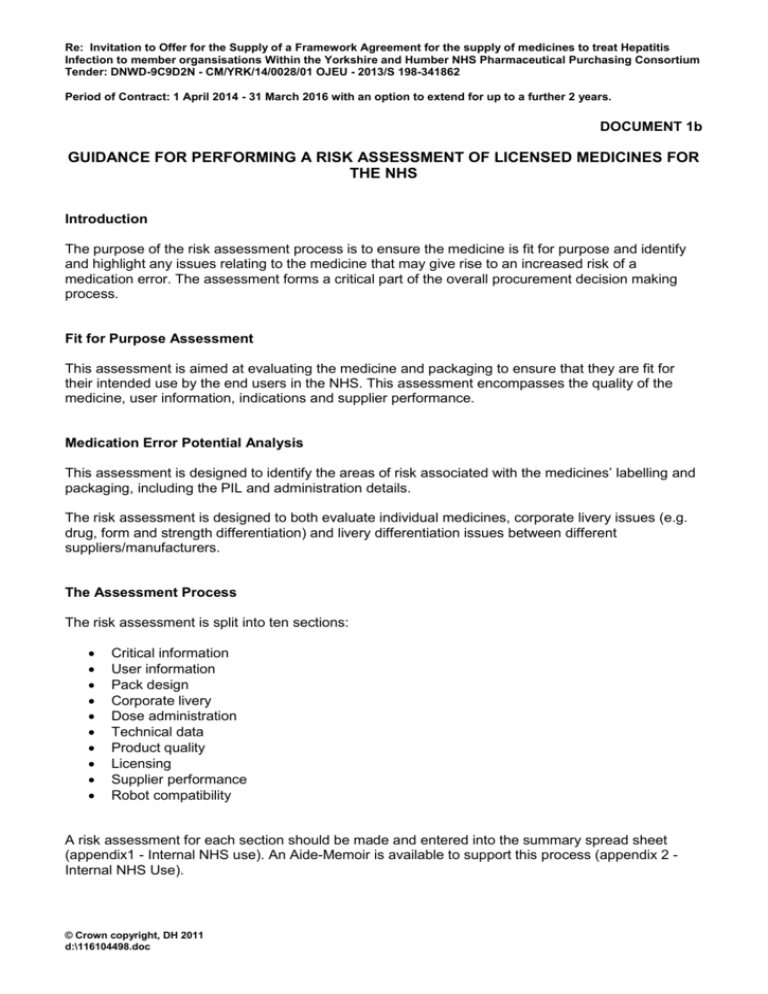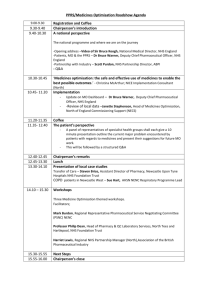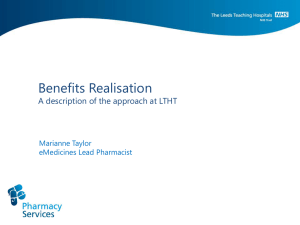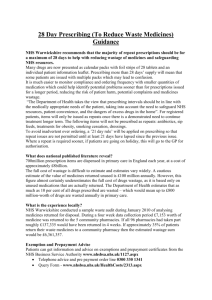Guidance for performing a risk assessment of licensed medicines for
advertisement

Re: Invitation to Offer for the Supply of a Framework Agreement for the supply of medicines to treat Hepatitis Infection to member organsisations Within the Yorkshire and Humber NHS Pharmaceutical Purchasing Consortium Tender: DNWD-9C9D2N - CM/YRK/14/0028/01 OJEU - 2013/S 198-341862 Period of Contract: 1 April 2014 - 31 March 2016 with an option to extend for up to a further 2 years. DOCUMENT 1b GUIDANCE FOR PERFORMING A RISK ASSESSMENT OF LICENSED MEDICINES FOR THE NHS Introduction The purpose of the risk assessment process is to ensure the medicine is fit for purpose and identify and highlight any issues relating to the medicine that may give rise to an increased risk of a medication error. The assessment forms a critical part of the overall procurement decision making process. Fit for Purpose Assessment This assessment is aimed at evaluating the medicine and packaging to ensure that they are fit for their intended use by the end users in the NHS. This assessment encompasses the quality of the medicine, user information, indications and supplier performance. Medication Error Potential Analysis This assessment is designed to identify the areas of risk associated with the medicines’ labelling and packaging, including the PIL and administration details. The risk assessment is designed to both evaluate individual medicines, corporate livery issues (e.g. drug, form and strength differentiation) and livery differentiation issues between different suppliers/manufacturers. The Assessment Process The risk assessment is split into ten sections: Critical information User information Pack design Corporate livery Dose administration Technical data Product quality Licensing Supplier performance Robot compatibility A risk assessment for each section should be made and entered into the summary spread sheet (appendix1 - Internal NHS use). An Aide-Memoir is available to support this process (appendix 2 Internal NHS Use). © Crown copyright, DH 2011 d:\116104498.doc Re: Invitation to Offer for the Supply of a Framework Agreement for the supply of medicines to treat Hepatitis Infection to member organsisations Within the Yorkshire and Humber NHS Pharmaceutical Purchasing Consortium Tender: DNWD-9C9D2N - CM/YRK/14/0028/01 OJEU - 2013/S 198-341862 Period of Contract: 1 April 2014 - 31 March 2016 with an option to extend for up to a further 2 years. For each section, the risk should be categorised as Critical (C), Major (M), Minor (O) or satisfactory (S). If no risk assessment is carried out in for a particular section, a ‘not assessed’ (N/A) entry should be made. Each section in the aide memoir is split into two criteria; essential and desirable. Any deficiencies in the essential criteria will lead to a critical or major risk rating for that section. Deficiencies in the desirable criteria will lead to a minor rating. Multiple failings in the desirable criteria may lead to a major rating. Any point of concern, should be documented in the comments section of the risk assessment summary to allow other assessors to review the issue. Where possible, a digital photograph of the issue should be taken and maintained on file. NB Every risk component will not necessarily be relevant to the medicine under adjudication. The assessor should then review the overall risk to the patient, based on the cumulative risk issues from each section. Overall risk should be categorised as High (H), medium (M) or Low (L). High Risk - There is a significant error potential and risk to patient safety, the product should not be placed on contract unless there is no alternative and that effective risk reduction measures are implemented. If any single risk category is deemed to be a critical risk, the product is automatically assigned a high overall risk rating. Medium Risk - There is a overall low/medium risk to patient safety, but there are medium/major risk issues that need to be addressed by the company prior to going on contract. Intermediate control measures such as safety action bulletins should be considered where appropriate. (If there is a product from another manufacturer with a low risk, then that product should be placed on contract.) Low Risk - no major risks identified, safe to go on contract without any corrective course of action. Reporting of Results The overall risk assessment for each product assessed is entered into the spreadsheet and reported to the contracting team. This should include the overall risk assessment rating, any associated comments and an uploaded digital image which clearly demonstrates the deficiency. Where it has been necessary to purchase a medicine having a medium or high medication error potential there will be local arrangements in place to inform users of the risk. Also, the findings should be communicated to the MHRA, NPSA and manufacturer. Suggested Actions for Medium/High Risk Rated Products Award the contract to a safer alternative where possible. Identify any risk reduction measures e.g. issue “caution in use”. Advise end users to perform a local risk assessment on the product. Change local practice if necessary (e.g. storage in different locations, ward briefings etc) Monitor effectiveness of risk management measures using local error reporting mechanisms. Inform Industry, regulatory body (MHRA), contracting & purchasing authority and National Patient Safety Agency when necessary. © Crown copyright, DH 2011 d:\116104498.doc Re: Invitation to Offer for the Supply of a Framework Agreement for the supply of medicines to treat Hepatitis Infection to member organsisations Within the Yorkshire and Humber NHS Pharmaceutical Purchasing Consortium Tender: DNWD-9C9D2N - CM/YRK/14/0028/01 OJEU - 2013/S 198-341862 Period of Contract: 1 April 2014 - 31 March 2016 with an option to extend for up to a further 2 years. RISK ASSESSMENT AIDE MEMOIR 1. Critical information Critical information is defined as: The generic name of the medicine The strength of the medicine The form of the medicine The route of administration Posology Warnings Essential criteria All critical information must be present (this includes small containers such as ampoules and vials). The name of the medicine expressed on the packaging should be the same as registered in the summary of product characteristics (SPC). NB this will be the brand name for a proprietary product, but the generic name should also be clearly expressed. No Abbreviations. If the medicine contains more than one active ingredient, all generic names should be clearly stated on the pack. ‘Co-‘ names should be as registered on the SPC and labelled as part of the name. Strengths should be clearly expressed and unambiguous. For injections, the strength should be expressed both as total quantity per total volume and as amount per unit dose (e.g milligrams per ml) where appropriate. Trailing zeros should not be used. Microgram doses should be spelt out rather than abbreviated. (NB pay special attention to different strengths/concentrations across injection product ranges). Base and salt strengths should be clearly defined where appropriate. Desirable Criteria The brand name should not sound similar to another generic or brand name in either appearance or sound. 2. User Information Essential criteria Only positive statements should be used on labels e.g. ‘For intravenous use only’. Negative statements such as ‘not for intrathecal use’ should not be used. All patient packs should include a patient information leaflet (PIL). NB The assessment process does not require a review of the content and design of the PIL, as this is reviewed by the licensing authority. The following two sections are for reference only. The PIL should provide the following key information: What the medicine is used for. © Crown copyright, DH 2011 d:\116104498.doc Re: Invitation to Offer for the Supply of a Framework Agreement for the supply of medicines to treat Hepatitis Infection to member organsisations Within the Yorkshire and Humber NHS Pharmaceutical Purchasing Consortium Tender: DNWD-9C9D2N - CM/YRK/14/0028/01 OJEU - 2013/S 198-341862 Period of Contract: 1 April 2014 - 31 March 2016 with an option to extend for up to a further 2 years. Any precautions prior to taking the medicine (allergies, contraindications, drug interactions, pregnancy and breast feeding guidance, driving/operating machinery etc.) How to take the medicine Possible side effects Storage requirements Information relating to other ingredients Product description. Company details - Name and address of MA holder and manufacturer. The design and layout of the PIL should allow the patient to easily find and understand the important messages within the leaflet. This should include: An index to allow easy navigation Consistent headings that stand out using larger font or bold text. Colour should only be used judiciously to allow good contrast of key messages. Good readability - text should adequately spaced and as large as possible. (dense text can lead to loss of concentration). The use of complex language and medical jargon should be avoided. Information should be translated into lay language. Side effects should be grouped by seriousness and should give clear guidance as to when to take action, and what the action should be. Related information should be located together. Repetition should be avoided. 3. Pack Design Essential criteria The critical information should be given due prominence and located together in the same field of view where practicable (i.e. these items should not be broken up by additional information, logos, background texts or graphics). When the name of the medicine is a Brand name, the generic name of the active ingredient should be given due prominence and should immediately follow the brand name on the pack. There should be no intervening text. The generic name and strength should appear on at least three non-opposing sides of pack (including “shelf” end). The marketing authorisation and name and address of the licence holder should be present on the pack. The batch number and expiry date should be present and legible. The expiry date should be unambiguously expressed. Desirable Criteria When relevant, colour should only be used judiciously to aid identification (consider innovative designs). The name & strength of the medicine should be printed legibly over each blister or oriented repeatedly across strip. Ampoules should be labelled longitudinally. © Crown copyright, DH 2011 d:\116104498.doc Re: Invitation to Offer for the Supply of a Framework Agreement for the supply of medicines to treat Hepatitis Infection to member organsisations Within the Yorkshire and Humber NHS Pharmaceutical Purchasing Consortium Tender: DNWD-9C9D2N - CM/YRK/14/0028/01 OJEU - 2013/S 198-341862 Period of Contract: 1 April 2014 - 31 March 2016 with an option to extend for up to a further 2 years. Patient packs should have a space for placement of the dispensing label. This should be a blank white space in which there is no text, to aid legibility of the dispensing label. Where it is not possible to employ a blank space, the pack should be of a colour that will not interfere with the readability of the dispensing label. 4. Corporate Livery Essential criteria There should be good differentiation between different medicines within the corporate livery of the company. Consideration should be given to similar or look-alike names (INN and Brand) and potential problems associated with storage due to alphabetical location. There should be good differentiation between strengths within the product range. There should be good differentiation between different formulations of the same product intended for different parenteral routes (e.g. intravenous and intrathecal). Desirable Criteria There should be good differentiation between dosage forms within product range. 5. Dose Administration Essential criteria Instructions for dosage manipulation should be clear and unambiguous (consideration should be given as to who will be administrating the medicine). If complicated calculations are required to calculate the dose (e.g. dilutions, conversions from milligrams to millimols, mg/kg dosing in children etc.), unambiguous instructions, conversion tables and/or labelling should be provided. If specific end user counselling is required, clear patient instructions should be provided to aid this process (e.g. inhalation devices used in asthma treatment). If additional devices are required to administer a dose, this should be supplied with the medicine along with clear instructions for its use. Desirable Criteria Medicines should be in a ready to administer dosage form whenever possible. If reconstitution or serial dilution is required, instructions must be prominent, clear and unambiguous. The SPC or specific user guidance should be included in the packaging for medicines requiring further manipulation by health professionals (e.g. fluid compatibility and infusion rates for injections). 6. Technical Data Essential criteria Displacement values should be provided for any injection requiring reconstitution. © Crown copyright, DH 2011 d:\116104498.doc Re: Invitation to Offer for the Supply of a Framework Agreement for the supply of medicines to treat Hepatitis Infection to member organsisations Within the Yorkshire and Humber NHS Pharmaceutical Purchasing Consortium Tender: DNWD-9C9D2N - CM/YRK/14/0028/01 OJEU - 2013/S 198-341862 Period of Contract: 1 April 2014 - 31 March 2016 with an option to extend for up to a further 2 years. Diluent compatibility data should be provided for any injectable dosage form that requires dilution or reconstitution prior to infusion. The recommended diluent should be clearly stated in the SPC and/or packaging. The shelf life and specified storage conditions following opening or reconstitution should be clearly stated in the SPC and on the packaging. Desirable Criteria Stability and compatibility data should be available for injectable medicines commonly prepared as infusions in aseptic units. This should include: Physio chemical compatibility with common diluents (saline, glucose % etc) Physio chemical compatibility with common containers + packaging (polypropylene, glass, PVC etc) Route of chemical degradation Physio – chemical compatibility with other drugs Degradation rate Shelf life at 4°C + 25°C in recommended diluents Validation for use with common reconstitution devices. 7. Product Quality Essential criteria Tablets and capsules should be marked for easy identification. Scored tablets should be easily halved. There should be no evidence of damage or lack of dose uniformity in tablets. Pack closures should be tamper evident Patient packs should have child resistant closures Powders intended for dissolution should dissolve easily. Suspensions and emulsions should re-suspend easily upon shaking. Labels on vials/ampoules intended for use in aseptic units should be resistant to spraying and wiping with alcohol. Desirable Criteria Tablets /capsules in blister packs should be easily ‘popped out’ and the blister pack should have no sharp edges. The taste of liquid formulations should be acceptable for all patient groups. Oral liquid medicines should be sugar free when specified and alcohol free.. Vials intended for reconstitution must be of sufficient size to allow reconstitution with the volume of diluent commonly used in aseptic units (not just to allow bolus administration at ward level). © Crown copyright, DH 2011 d:\116104498.doc Re: Invitation to Offer for the Supply of a Framework Agreement for the supply of medicines to treat Hepatitis Infection to member organsisations Within the Yorkshire and Humber NHS Pharmaceutical Purchasing Consortium Tender: DNWD-9C9D2N - CM/YRK/14/0028/01 OJEU - 2013/S 198-341862 Period of Contract: 1 April 2014 - 31 March 2016 with an option to extend for up to a further 2 years. 8. Licensing Essential criteria The medicine must be licensed for use in the UK. The licensed routes of administration should be clear and obvious. The licensed indications and routes of administration should be comparable to the brand leader where appropriate. Desirable Criteria None 9. Manufacturer Performance The performance of the manufacturer is assessed using the following performance indicators: A review of any recalls associated with the medicines or company. A review of any minor defects reported for the medicine or company. A review of issues reported to PASA. A review of the manufacturer’s response to complaints and technical data requests. A review of any supplier audits taken on behalf of the NHS. Essential criteria The frequency of problems reported for the manufacturer should not be unusually high. The company should respond in a timely and professional manner to any complaint or technical request. Desirable Criteria The company should respond favourably to medication error potential risk assessments and work collaboratively with the NHS in rectifying any issues. 10. Robot Compatibility NB. Robot compatibility can only be assessed locally as the requirements are specific to the model used. Guidance can be found in appendix 1: Criteria for Inserting Products into Robotic Automated Systems. Essential criteria The pack integrity, dimensions and layout should be compatible with automated dispensing systems. A bar code should be present on the pack and not in the space dedicated to the patient label. © Crown copyright, DH 2011 d:\116104498.doc





